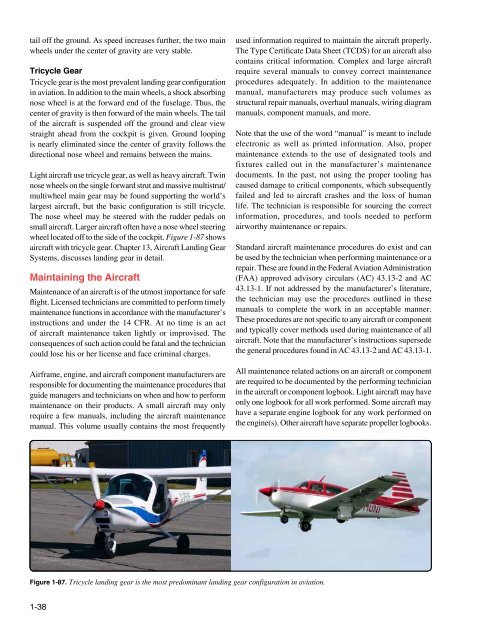You also want an ePaper? Increase the reach of your titles
YUMPU automatically turns print PDFs into web optimized ePapers that Google loves.
tail off the ground. As speed increases further, the two main<br />
wheels under the center of gravity are very stable.<br />
Tricycle Gear<br />
Tricycle gear is the most prevalent landing gear configuration<br />
in aviation. In addition to the main wheels, a shock absorbing<br />
nose wheel is at the forward end of the fuselage. Thus, the<br />
center of gravity is then forward of the main wheels. The tail<br />
of the aircraft is suspended off the ground and clear view<br />
straight ahead from the cockpit is given. Ground looping<br />
is nearly eliminated since the center of gravity follows the<br />
directional nose wheel and remains between the mains.<br />
Light aircraft use tricycle gear, as well as heavy aircraft. Twin<br />
nose wheels on the single forward strut and massive multistrut/<br />
multiwheel main gear may be found supporting the world’s<br />
largest aircraft, but the basic configuration is still tricycle.<br />
The nose wheel may be steered with the rudder pedals on<br />
small aircraft. Larger aircraft often have a nose wheel steering<br />
wheel located off to the side of the cockpit. Figure 1-87 shows<br />
aircraft with tricycle gear. Chapter 13, <strong>Aircraft</strong> Landing Gear<br />
Systems, discusses landing gear in detail.<br />
Maintaining the <strong>Aircraft</strong><br />
Maintenance of an aircraft is of the utmost importance for safe<br />
flight. Licensed technicians are committed to perform timely<br />
maintenance functions in accordance with the manufacturer’s<br />
instructions and under the 14 CFR. At no time is an act<br />
of aircraft maintenance taken lightly or improvised. The<br />
consequences of such action could be fatal and the technician<br />
could lose his or her license and face criminal charges.<br />
Airframe, engine, and aircraft component manufacturers are<br />
responsible for documenting the maintenance procedures that<br />
guide managers and technicians on when and how to perform<br />
maintenance on their products. A small aircraft may only<br />
require a few manuals, including the aircraft maintenance<br />
manual. This volume usually contains the most frequently<br />
used information required to maintain the aircraft properly.<br />
The Type Certificate Data Sheet (TCDS) for an aircraft also<br />
contains critical information. Complex and large aircraft<br />
require several manuals to convey correct maintenance<br />
procedures adequately. In addition to the maintenance<br />
manual, manufacturers may produce such volumes as<br />
structural repair manuals, overhaul manuals, wiring diagram<br />
manuals, component manuals, and more.<br />
Note that the use of the word “manual” is meant to include<br />
electronic as well as printed information. Also, proper<br />
maintenance extends to the use of designated tools and<br />
fixtures called out in the manufacturer’s maintenance<br />
documents. In the past, not using the proper tooling has<br />
caused damage to critical components, which subsequently<br />
failed and led to aircraft crashes and the loss of human<br />
life. The technician is responsible for sourcing the correct<br />
information, procedures, and tools needed to perform<br />
airworthy maintenance or repairs.<br />
Standard aircraft maintenance procedures do exist and can<br />
be used by the technician when performing maintenance or a<br />
repair. These are found in the Federal Aviation Administration<br />
(FAA) approved advisory circulars (AC) 43.13-2 and AC<br />
43.13-1. If not addressed by the manufacturer’s literature,<br />
the technician may use the procedures outlined in these<br />
manuals to complete the work in an acceptable manner.<br />
These procedures are not specific to any aircraft or component<br />
and typically cover methods used during maintenance of all<br />
aircraft. Note that the manufacturer’s instructions supersede<br />
the general procedures found in AC 43.13-2 and AC 43.13-1.<br />
All maintenance related actions on an aircraft or component<br />
are required to be documented by the performing technician<br />
in the aircraft or component logbook. Light aircraft may have<br />
only one logbook for all work performed. Some aircraft may<br />
have a separate engine logbook for any work performed on<br />
the engine(s). Other aircraft have separate propeller logbooks.<br />
Figure 1-87. Tricycle landing gear is the most predominant landing gear configuration in aviation.<br />
1-38



